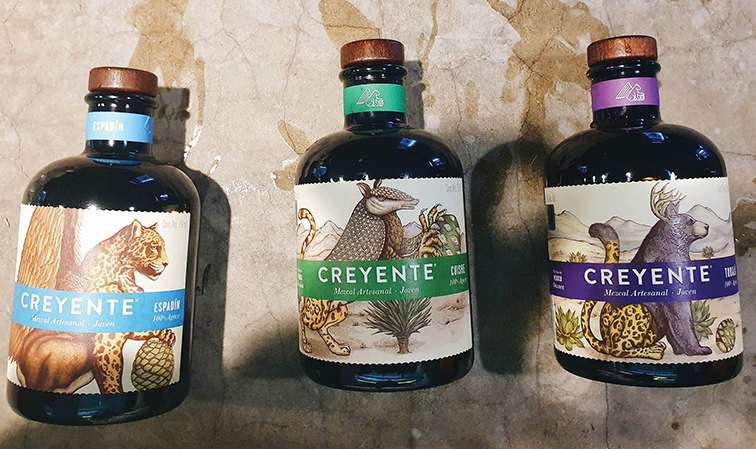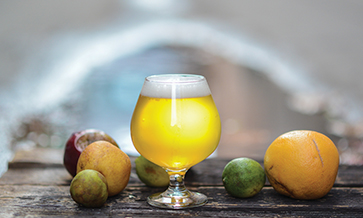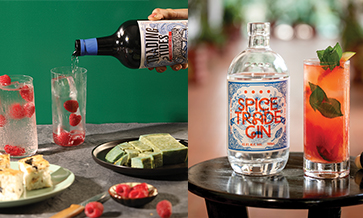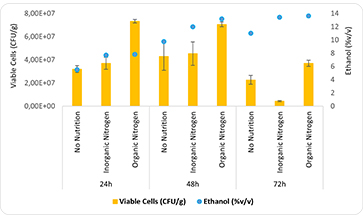In 1795, Don Jose Antonio de Cuervo first commercially produced ‘Mezcal de Tequila de Jose Cuervo’ , which essentially meant Mezcal produced in the town of Tequila by Jose Cuervo (it’s a real town!). This event laid the grounds for the Tequila category and the spirit became all so famous around the world.
What remained the background on the global scene was Mezcal, the older, smokier hermano of Tequila. The creation of Mezcal dates back to pre-Spanish Mexico where the Maguey (agave) was considered to be one of the most sacred plants. The Aztecs held the plant in great regard for its many uses.
Mayahuel, the Aztec goddess of Maguey and Pulque (a fermented alcoholic beverage), was also a symbol of fertility and prosperity. Early distilled liquors in Mexico were called aguardiente (fire water) and, after supply had run out, further exploration and experimentation with Maguey began, and so was Mezcal born.
Many varieties
There are 330 species of agave in the world. Mexico has about 150 of them. The Norma in Mexico allows for some more than 30 species that can be used to make Mezcals.
Tequila can be made from only one variety of agave: the Tequiliana Azul Weber, or popularly Weber blue agave.
The most famous and most widely used agave to make Mezcal is the Espadin agave, a variety very similar to the Weber blue agave in shape, size and lifecycle.
The Spanish landed in Mexico on the Yucatan Peninsula, which was the land of the Mayans. Folks there were already drinking Pulque, a traditional drink made by leaving agave juice in the sun to ferment naturally.
From the Yucatan Peninsula the Spaniards made their way to Oaxaca, the Mecca of civilisation in the New World they had discovered. Today Oaxaca is considered to be the capital of Mezcal. Many modern-day Mezcals belong to this region.
On the basis of production techniques Mezcals can be classified as one of the following:
- Mezcal Ancestral: a very aggressive, high-on-alcohol spirit produced by using old school methods;
- Mezcal Industrial: a spirit produced using the latest technology and techniques;
- Mezcal Artisanal: a spirit obtained from a mélange of traditions from the past and refining some processes with modern-era magic.
Crucial harvest
Different producers use different agave from different kinds of fields. Some are cultivated, some are semi-cultivated, and then of course there are producers that venture into the wild and forage their agave. Creyente Mezcal, which belongs to the Mezcal artisanal cluster, uses semi-cultivated plants. This is to give back and help earth live and be as nature meant it to be.
Some agave plants take up to 8 years to mature. And there are varieties that take a whopping 20 years to do so. On maturation a bloom, known as Quiote, comes out of the agave plant. This bloom develops the flowers and the seeds that producers use for re-cultivation.
This bloom and the Pincas (the leaves of the agave plant) are removed to reveal the heart of the agave, known as the Pina. It is called that because it looks like a giant pineapple.
The way that the plant is harvested is very crucial to determine the final flavour of the spirit. The more leaves that an agave has, the more the spirit will have vegetal characteristics. Using the absolute centre will lead to a Mezcal with fruiter and sweeter notes.
Palenque is the name used for Mezcal distilleries. This is where the agave is roasted, crushed, fermented, distilled and bottled.
The Pina has a concentration of a carbohydrate called Inulin in it. To convert it to more fermentable sugars, cooking takes place. In the Tequila industry the Pina’s are sometimes steamed (like Jose Cuervo does) or cooked in autoclaves (giant industrial ovens). Mezcal producers generally cook the Pina in direct contact with the heat.
Traditional ways
Traditional cooking methods used for making an ancestral or artisanal Mezcals use traditional stone ovens. The fuel is wood, coal, stones and agave fibre from previous production cycles. Creyente Mezcal uses Mesquite wood, amongst other things, for cooking the Espadin.
Traditionally volcanic stones are used in the fire, as it does not affect the flavour profile of the final spirit. The fibres help control the heat, preventing the agave from burning. Some producers also put banana or pineapple leaves to the mix to add tropical complexity.
Depending on the size of the oven and the amount of agave, cooking goes on for about 3-5 days. The heat turns the agave into a soft sponge-like texture which is milled to get the fermentable agave juice.
Traditionally a big round stone called Tahona, is used for the grinding. In olden days a donkey or horse would make the stone move; but in modern times many producers have switched to mechanical means.
Traditional fermentation is done in open Oak tanks of small sizes. Depending on the weather, it takes up to 7 days for the fermentation to complete. Some religious producers put a cross in the fermentation tanks when the process is complete.
Spirituality and traditions are in the essence of the people of Mexico. Traditional stills are made from stones, bricks and copper and are considerably small in size.
Generally, two distillations are run to reach an ABV of 55-60%. Water is added to soften the spirit and gotten to around 40% ABV before it is bottled.
Ageing might also be carried out in wooden barrels. According to the time spent in a barrel Mezcals can be:
- Joven Mezcal: up to 2 months spent in a barrel
- Reposado Mezcal: 2 to 12 months in a barrel
- Anejo Mezcal: at least one year in a barrel
Espadin agave
The intricacies of Mezcal are numerous and will never fit into one article. I want to go to Mexico and experience all of it first-hand. Talking about Mezcal is a lot like talking about wine: so many varieties (like grape), different production processes, effects of terroir, ageing, etc.
Creyente is a beautiful introduction to the world of Mezcals. Made from the Espadin agave it has a velvety smooth body, with sweet hints of fruit and light herbal notes. The flavour notes are attained from the rich soils of Tlacolula and wild, mountainous terrain of Yautepec within Oxaca, from where the agave is sourced.
The traditional serves for Mezcal include pairing it with Sangritas or Sal de gusano (worm salt). The salt is never added next to the rim of the glass so as not to affect the flavour profile of the Mezcal.
In Oxaca, you can see worms and grasshoppers (Chapulines) being dried, smoked and eaten as snacks next to Mezcal. The crunchiness (like that of potato chips) takes your Mezcal drinking experience a step further.
For folks sitting far away from Mexico, we could try a Mezcal at our favourite bar, or just go buy a bottle from the store. The first whiff that you get will remind you of smoke, before setting off to a layered flavour experience that started growing in Mexico a long time ago.
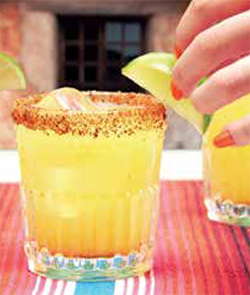
Creyente Espadin Mezcal: 50ml
Fresh lime juice: 30ml
Agave syrup: 15ml
Directions: Shake all the ingredients with ice. Strain into an Old Fashioned glass with fresh ice. Garnish with smoked salt on the rim with a lime wedge and a rosemary stick.

Creyente Espadin Mezcal: 45ml
Tonic water: 120ml
One lime wedge (one-sixth of a lime)
Directions: Fill a Highball glass with ice. Squeeze the lime over the ice to ‘season’ it, and drop it into the glass. Add Creyente and top with tonic. Stir briefly. Add a splash of olive brine to make it a bit dirty.
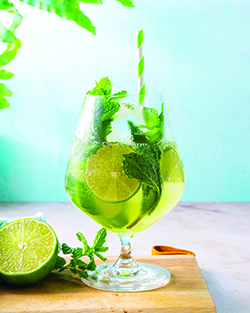
Creyente Espadin Mezcal: 30ml
1800 silver: 15ml
Lime juice: 15ml
Tomato juice: 90ml
Chicken/ vegetable broth: 60ml
Hot sauce: 3-4 dashes
Directions: Rim the glass with lime, then salt. Build all the ingredients in a glass, add ice and stir. Garnish with a wedge of lime and a copita (shot) of Creyente. Meant to be sipped one after the other.
- by James Bailey (adjusted to availability of ingredients in India)
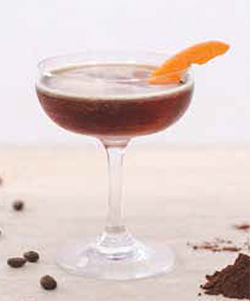
Creyente Espadin Mezcal: 45ml
Espresso: 30ml
Simple syrup: 30ml
Dash of aromatic bitters
Pinch of cocoa powder
Directions: Combine all the ingredients in a shaker and shake with ice. Double-strain into a chilled coupe glass. Garnish with a pinch of cocoa powder and an orange twist.
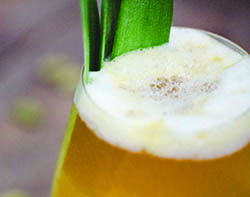
Creyente Espadin Mezcal: 45ml
Fresh pineapple juice: 60ml
Simple syrup: 15ml
Pinch of cardamom & pink salt
Light beer: 60ml
Directions: Shake all ingredients (except beer) with ice. Strain into a wine glass and top it up with the beer. Garnish with a pinch of cardamom and pineapple leaves.
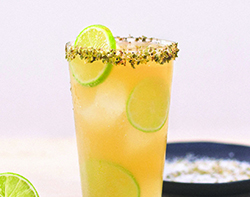
Creyente Espadin Mezcal: 45ml
Fresh orange juice: 60ml
Lemon juice: 30ml
Pinch of oregano salt
Light beer: 60ml
Directions: Shake all ingredients (except beer) with ice. Strain into a tall glass with oregano salt rim and top it up with the beer. Garnish with lime wheels.











